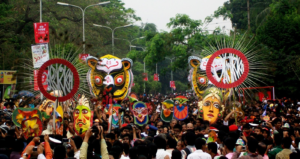Pohela Boishakh

Pohela Boishakh is the traditional New Year celebrated by Bengali people across Bangladesh, India and the world. The event takes place on the first day of the Lunisolar Bengali calendar, which on the Gregorian calendar, usually falls on April 14.
In 1966, the Bengali calendar was modified so that the first 5 months had 31 days and the rest in the year had 30 days. This change was made by Muhammad Shahidullah. From then on, New Year was celebrated from April 14.
Just as on the Gregorian New Year, we say “Happy New Year”, on Pohela Boishakh the traditional greeting is “Shubho Nabobarsho”, which literally translates to Happy New Year.
Historians speculate that Pohela Boishakh is related to Vaisakhi (and other names), another Hindu festival. Vaisakhi is an ancient harvest festival celebrated in the Punjab (North India) particularly.
Now-a-days, Pohela Boishakh is celebrated with enormous crowds gathering at fairs and treats being offered. Various food items and toys are given out to the people at these events. The most famous of these celebrations is “Mangal Shobhajatra”. Mangal Shobhajatra celebrates the pride that Bengalis have in their heritage, their courage to fight against evil and their vindication for truth and justice.
In 1989, a group of student of the Art school of Dhaka University (Bangladesh) started “Mangal Shobhajatra” with the idea of dances and performances with masks of various traditional things. This year elephants, tigers, birds and flowers were the focus of the celebration in Dhaka. For the first time, the neighbouring country, Kolkata (India), also celebrated “Mangal Shobhajatra” with the inspiration from Dhaka.
Bengalis across Australia also celebrate Pohela Boishakh traditionally. The biggest celebration of Pohela Boishakh in Australia took place in Sydney with traditional cultural programs and food. The dress code is mainly red and white saris and punjabis, and the foods include Ilish Bhaja and Panta Bhat (a fried fish with a rice dish), Jhal Muri (spicy rice puffs), Bhapa Pitha (a coconut based dessert) and Naru (a sweet coconut ball) just to name a few.
Pohela Boishakh is a huge celebration, so big that UNESCO decided to recognise it and claim it as the Intangible Cultural Heritage of Humanity. It invites all people across the world to celebrate. Every individual makes the celebration his or hers own. Regardless of race, age or gender, Pohela Boishakh is for everyone because it spreads a deep and strong message for a shared value of democracy.
Related Articles
মেলবোর্নের চিঠি – ১২
কুমড়ো ফুলে-ফুলে; নুয়ে পড়েছে লতাটা, সজনে ডাঁটায় ভরে গ্যাছে গাছটা আর, আমি; ডালের বড়ি শুকিয়ে রেখেছি, খোকা তুই কবে আসবি।
Agun na Golap
আগুন না গোলাপ? -ড. ফরিদ আহমেদ ড. কামাল হোসেন, বীর উত্তম কাদের সিদ্দিকী,অলি আহমেদ এবং আরোও অনেকে বলছেন দেশ সংঘাতের
আমাদের মঞ্জুর মোরশেদ
১৯৯১ সালের এক বিকেলের ঘটনা৷ হার্ডডিস্কের তথ্য সংরক্ষণের নতুন কার্যপদ্ধতি (অ্যালগরিদম) নিয়ে একটি বৈজ্ঞানিক নিবন্ধের খসড়া করে সেটি সম্পূর্ণ করার








